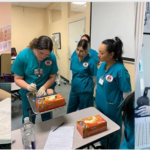.jpg)
Fashion shows are a dazzling spectacle of creativity, talent, and style that captivate audiences around the world. From the exquisite designs to the flawless runway presentations, fashion shows are a culmination of meticulous planning and artistic expression. In this comprehensive guide, we will delve into the captivating world of fashion shows, exploring their purpose, organization, and the myriad roles that bring them to life. From the pivotal contributions of fashion designers, models, stylists, makeup artists, and hair stylists to the intricate behind-the-scenes preparations, we will uncover the inner workings of these grand productions. We will shed light on the challenges of organizing fashion shows, including adapting to evolving trends and navigating the financial considerations. Join us as we unravel the enchanting world of fashion shows, where creativity, innovation, and sophistication converge on the runway.
What Are Fashion Shows?
Fashion shows are glamorous events that showcase the latest trends and designs in the fashion industry, often setting the tone for trendsetting and high fashion on the runway.
They serve as a creative platform for designers to present their artistic visions to a global audience, influencing the direction of fashion. These events not only amplify the visibility of established and emerging designers but also inspire individuals to experiment with their personal style.
Fashion shows help shape consumer preferences and drive the demand for new collections, contributing significantly to the dynamism and evolution of the fashion industry.
What Is the Purpose of Fashion Shows?
The purpose of fashion shows is to present exclusive and luxurious collections, showcasing the creativity and craftsmanship of designers while setting the stage for the latest fashionable trends during events like Fashion Week.
These events serve as a platform for designers and brands to exhibit their vision of luxury and elegance, creating a sense of desire and aspiration in the audience. By featuring the most current fashion trends, fashion shows establish the bar for what will be considered chic and desirable in the upcoming seasons, elevating the aura of exclusivity and desirability around the showcased clothing and accessories.
They also provide an opportunity for industry insiders and high-profile clients to preview and procure the latest creations, further enhancing the allure of these prestigious events.
How Are Fashion Shows Organized?
Fashion shows are meticulously organized events that involve the coordination of fashion designers, models, photographers, makeup artists, and hairstylists to bring the creative vision to life on the runway.
They require seamless collaboration between the designers, who conceptualize and create the collections, the models who showcase the designs on the runway, the photographers who capture the essence of the show, and the makeup artists and hairstylists who enhance the overall presentation with their creativity and expertise. Each entity plays a crucial role in ensuring that the fashion show reflects the unique style and vision of the designer while maintaining a cohesive and captivating presentation for the audience.
What Is the Role of Fashion Designers?
Fashion designers play a pivotal role in curating clothing collections, defining styles, and shaping haute couture trends, contributing to the creative landscape of the fashion industry.
They are responsible for translating their visions into tangible designs that reflect the spirit of the times, ultimately influencing the way people dress and express themselves. Through their innovation and creativity, fashion designers push the boundaries of conventional attire, ushering in new trends and redefining the art of fashion design.
Their meticulous attention to detail and understanding of fabric, color, and form set the stage for the evolution of clothing aesthetics and the constant reinvention of style.
What Is the Role of Models?
Models are essential participants in fashion shows, showcasing the creations of fashion brands on the catwalk during runway shows, effectively embodying the essence of fashion models.
They not only display the latest designs with grace and poise, but also serve as the quintessential representatives of the fashion industry. Their presence on the catwalk captivates audiences, setting trends and inspiring fashion enthusiasts worldwide. These influential individuals shape the narrative of fashion, bringing life to the designer’s vision and adding a touch of glamour to the runway.
Through their charisma and distinctive style, they leave an indelible mark, influencing the way people perceive and embrace fashion trends.
What Is the Role of Stylists?
Stylists contribute to the exclusive and fashionable aura of fashion shows through their expertise in fashion styling, ensuring that each presentation exudes the essence of high fashion and elegance.
They meticulously curate ensembles, accessorize looks, and tailor each outfit to perfection, fostering a seamless integration of luxury and sophistication. Their discerning eye for detail and trends elevates the overall appeal of the show, creating captivating and influential moments that define the landscape of high fashion.
Stylists play a crucial role in shaping the narrative and visual storytelling, establishing a cohesive and compelling sartorial language that resonates with the audience.”
What Is the Role of Makeup Artists and Hair Stylists?
Makeup artists and hair stylists contribute to the glamour and exclusivity of fashion shows by showcasing their expertise in fashion makeup and hairstyling, adding an element of luxury and sophistication to the overall presentation.
They play a pivotal role in translating the designer’s vision into a cohesive look that complements the fashion collection. By skillfully accentuating features and creating intricate hairstyles, they elevate the entire runway experience. Their artistry helps bring out the essence of the fashion pieces, giving them an added allure and creating an atmosphere of opulence.
Their attention to detail and ability to capture the essence of the designer’s aesthetic make them indispensable in the fashion world.
What Happens Behind the Scenes of Fashion Shows?
Behind the scenes of fashion shows, a flurry of activity occurs in the backstage area, where fashionable trends are brought to life, captured through fashion photography, and contribute to the overall trendsetting atmosphere of the event.
This bustling environment is where makeup artists, hairstylists, and designers work tirelessly to perfect every detail before the models hit the runway. The backstage area becomes a hive of creativity, with photographers capturing candid moments, essential for fashion magazines and online media. The seamless coordination between stylists, designers, and photographers is what brings together the iconic images that define fashion trends and inspire the industry.
How Are Clothes and Accessories Chosen for the Show?
The selection of clothing and accessories for fashion shows revolves around the curation of fashionable and luxurious ensembles that showcase the creative visions of designers, reflecting the latest high fashion trends.
Stylists and designers meticulously evaluate the latest fashion trends, seeking garments and accessories that convey a sense of high fashion appeal and individual creativity. The emphasis is on discovering pieces that harmonize with the designer’s collection, offering a blend of luxury and innovation. Each garment and accessory is scrutinized to ensure coherence with the overall aesthetic of the show, capturing the essence of sophistication and elegance that characterizes the world of high fashion.
How Are Models Casted for the Show?
The casting of models for fashion shows involves a meticulous selection process by fashion designers to ensure that the chosen individuals effectively embody the essence of their creative vision, enhancing the visual impact of the runway show.
Designers carefully consider factors such as the models’ unique look, runway presence, and ability to convey the mood and style of the collection. They often collaborate with casting directors to find models who can bring their designs to life on the runway.
This process involves extensive auditions and fittings to determine the right fit for each garment and the overall aesthetic of the show. Ultimately, the selected models play a crucial role in translating the designer’s vision into an unforgettable runway presentation.
What Happens During Rehearsals?
Rehearsals for fashion shows encompass meticulous choreography, lighting adjustments, sound arrangements, and music selections, ensuring a seamless and captivating presentation on the runway.
As the models practice their strides and poses, the choreography is meticulously refined to synchronize with the selected music, creating a captivating visual spectacle. Simultaneously, lighting adjustments are made to accentuate the garments and set the mood, while sound arrangements are fine-tuned to enhance the overall atmosphere.
The music selections play a crucial role in setting the pace and tone of the show, undergoing careful considerations to complement the designs and themes. Through this integrated approach, rehearsals for fashion shows aim to deliver a mesmerizing and unforgettable experience for the audience.
What Are the Technical Aspects of a Fashion Show?
The technical aspects of a fashion show encompass the orchestration of lighting, sound engineering, music coordination, and logistical planning, ensuring a seamless and captivating event experience.
Lighting design plays a crucial role in enhancing the visual impact of the runway, creating dynamic atmospheres and highlighting the intricate details of the garments. Sound management is essential for maintaining clarity in music and spoken elements, ensuring that the audience can fully engage with the show.
Coordinating the music selection with the thematic elements of the collection adds an emotional dimension to the presentation. Logistical considerations such as backstage flow, model lineup, and stage transitions are meticulously coordinated to uphold the show’s fluidity and organization.
What Are the Challenges of Organizing a Fashion Show?
Organizing a fashion show presents various challenges, including adapting to evolving fashion trends, managing financial considerations, and ensuring the seamless execution of the event within the dynamic fashion industry landscape.
The fast-paced nature of fashion means that show organizers must constantly monitor and respond to changes in styles and preferences. This requires them to have a keen eye for emerging trends and the ability to forecast what will captivate their audience.
The financial aspect demands careful budgeting to orchestrate a visually stunning show while staying within financial constraints. The dynamic nature of the fashion industry demands flexibility and adaptability to accommodate last-minute changes and unexpected developments.
How Do Fashion Shows Adapt to Changing Trends?
Fashion shows adapt to changing trends through the expertise of industry professionals, meticulous planning, and choreography adjustments, ensuring that the event resonates with the dynamic fashion landscape.
These industry professionals have an acute understanding of fashion trends, allowing them to curate a captivating experience for the audience. The planning strategies encompass thorough market research, identifying upcoming styles, and aligning the show with the current zeitgeist.
Choreography adjustments are pivotal in synchronizing the presentation of garments with the overarching theme, ensuring a seamless and impactful showcase. By integrating technology and innovative concepts, fashion shows continue to evolve while staying at the forefront of the fashion industry.”
What Are the Financial Considerations for Fashion Shows?
Financial considerations for fashion shows encompass logistical planning, strategic marketing initiatives, and securing sponsorships to ensure the successful execution of the event within the competitive fashion show landscape.
Logistical planning plays a pivotal role in managing the venue, production, and coordination of models and designers. It involves meticulous budgeting for venue rentals, lighting, sound equipment, and staff.
Strategic marketing initiatives are crucial for creating buzz around the event, attracting attendees, and generating revenue through ticket sales and merchandise. Securing sponsorships is equally important for financial support, as it not only provides funding but also enhances the show’s reputation through brand associations. Effective negotiation and strong networking skills are essential in acquiring sponsorships from fashion brands and other relevant businesses.
Frequently Asked Questions
What does “glamour on the runway” mean?
Glamour on the runway refers to the high-fashion and luxurious atmosphere of a fashion show, where models showcase the latest designs and trends.
What happens behind the scenes of a fashion show?
Behind the scenes of a fashion show, there is a flurry of activity as designers, stylists, makeup artists, and models work together to bring the runway looks to life.
What is the role of reference data in a fashion show?
Reference data, such as measurements, fabric swatches, and sketches, are essential in ensuring that the designs on the runway match the designer’s vision and meet the required standards.
How are models selected for fashion shows?
Models are selected for fashion shows based on their unique look, height, and measurements that fit the designer’s clothing samples. They also go through castings and fittings to ensure a perfect fit for the runway.
What is the atmosphere like at a fashion show?
The atmosphere at a fashion show is usually electric and fast-paced, with music, lights, and a large audience. There is a sense of excitement and anticipation as the latest fashion trends are revealed on the runway.
What happens after a fashion show ends?
After a fashion show ends, the designers and their teams begin to collect their pieces and pack up. Models change out of their runway looks, and industry professionals may network and discuss the designs. The next steps include garment production and marketing the showcased collections.





